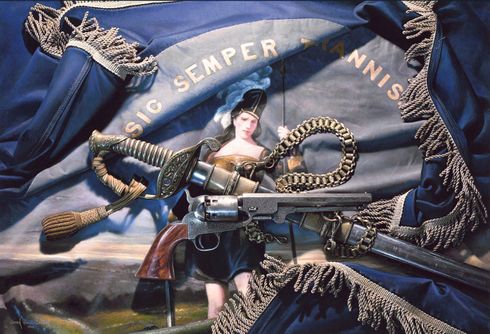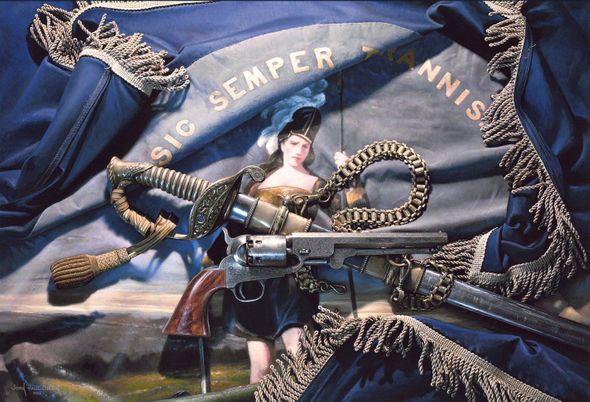
Sic Semper Tyrannis
Artist: John Paul Strain
Title: Sic Semper Tyrannis
Image Size:
Medium: Giclee on Paper and Canvas
Certificate of Authenticity: Included with every edition
Remarques: Featured on Artist's Proof Paper Giclee Edition
Title: Sic Semper Tyrannis
Image Size:
- Paper: 19" x 28"
- Studio Canvas: 12.75" x 18.75"
- Classic Canvas: 19" x 28"
- Executive Canvas: 26" x 38"
Medium: Giclee on Paper and Canvas
Certificate of Authenticity: Included with every edition
Remarques: Featured on Artist's Proof Paper Giclee Edition
About the Art
SIC SEMPER TYRANNIS
General Robert E. Lee's Colt Revolver
In 1775, the Revolutionary War began in earnest as American patriots fought the British army for their independence. The founders of the Constitution met at the second Continental Congress in Philadelphia, and George Washington was named Commander in Chief of the Continental Army.
By June of 1776, the Virginia legislature had adopted Virginia's Declaration of Rights and the First Virginia Constitution. A seal for the Commonwealth of Virginia was needed, and delegate George Mason recommended the phrase "Sic Semper Tyrannis" (Thus Always to Tyrants), be included. The seal artwork was designed by George Wythe and featured the Goddess of Virtue holding a sword and spear, resting her foot on the tyrant King George. Wythe was a distinguished Virginia judge, a signatory of the Declaration of Independence, and a Founding Father of the United States. Wythe was also a law professor and mentored Thomas Jefferson, Henry Clay and John Marshall.
In May of 1861, the Virginia legislature voted to secede from the Federal government and join the Confederate States of America. The convention of delegates also approved an ordinance to establish a flag for the commonwealth, adopting the pattern of the Virginia state seal of 1776 surrounded by a blue field. Virginia brigades would carry these hand painted flags featuring the Goddess of Virtue and motto "Sic Semper Tyrannis" into battle against invading federal forces.
Confederate officers often purchased their own swords after obtaining a commission in the army. These swords varied in quality as well as intricacy in design, depending on the officer's rank and wealth. It was fairly common for Generals of the highest rank to carry an ornate sword, possibly with brass fittings, silver plated handle, and their name engraved on the scabbard. Sometimes, these elegant swords were donated to the generals by a grateful citizen.
General Robert E. Lee of Virginia, carried a Colt 1851 Navy revolver, 3rd model - 36 cal. 6-shot round cylinder, with a 7 1/2" octagonal barrel. The piece featured a brass front bead, one piece walnut handle, silver plated brass trigger guard, and backstrap. The revolver was engraved by the W.L. Armsby Company, New York, and had the serial number 37698. After the war, Lee kept the revolver in a holster hanging from the headboard in his bedroom. General Lee would pass away on October 12, 1870. His revolver was then emptied with all six shots firing.
The motto, "Sic Semper Tyrannis", still adorns the Virginia State flag to this day. Robert E. Lee's revolver can be seen in the American Museum of the Civil War, in Richmond, Virginia.
General Robert E. Lee's Colt Revolver
In 1775, the Revolutionary War began in earnest as American patriots fought the British army for their independence. The founders of the Constitution met at the second Continental Congress in Philadelphia, and George Washington was named Commander in Chief of the Continental Army.
By June of 1776, the Virginia legislature had adopted Virginia's Declaration of Rights and the First Virginia Constitution. A seal for the Commonwealth of Virginia was needed, and delegate George Mason recommended the phrase "Sic Semper Tyrannis" (Thus Always to Tyrants), be included. The seal artwork was designed by George Wythe and featured the Goddess of Virtue holding a sword and spear, resting her foot on the tyrant King George. Wythe was a distinguished Virginia judge, a signatory of the Declaration of Independence, and a Founding Father of the United States. Wythe was also a law professor and mentored Thomas Jefferson, Henry Clay and John Marshall.
In May of 1861, the Virginia legislature voted to secede from the Federal government and join the Confederate States of America. The convention of delegates also approved an ordinance to establish a flag for the commonwealth, adopting the pattern of the Virginia state seal of 1776 surrounded by a blue field. Virginia brigades would carry these hand painted flags featuring the Goddess of Virtue and motto "Sic Semper Tyrannis" into battle against invading federal forces.
Confederate officers often purchased their own swords after obtaining a commission in the army. These swords varied in quality as well as intricacy in design, depending on the officer's rank and wealth. It was fairly common for Generals of the highest rank to carry an ornate sword, possibly with brass fittings, silver plated handle, and their name engraved on the scabbard. Sometimes, these elegant swords were donated to the generals by a grateful citizen.
General Robert E. Lee of Virginia, carried a Colt 1851 Navy revolver, 3rd model - 36 cal. 6-shot round cylinder, with a 7 1/2" octagonal barrel. The piece featured a brass front bead, one piece walnut handle, silver plated brass trigger guard, and backstrap. The revolver was engraved by the W.L. Armsby Company, New York, and had the serial number 37698. After the war, Lee kept the revolver in a holster hanging from the headboard in his bedroom. General Lee would pass away on October 12, 1870. His revolver was then emptied with all six shots firing.
The motto, "Sic Semper Tyrannis", still adorns the Virginia State flag to this day. Robert E. Lee's revolver can be seen in the American Museum of the Civil War, in Richmond, Virginia.
Edition Details
| Type | Edition Size | Image Size | Price |
|---|---|---|---|
| Paper Giclee (S/N) | 200 | 19" x 28" | $275 |
| Paper Giclee (Artist's Proof, Remarque) | 50 | 19" x 28" | $375 |
| Studio Canvas Giclee (S/N) | 100 | 12.75" x 18.75" | $275 |
| Studio Canvas Giclee (Artist's Proof) | 15 | 12.75" x 18.75" | $375 |
| Classic Canvas Giclee (S/N) | 100 | 19" x 28" | $575 |
| Classic Canvas Giclee (Artist's Proof) | 15 | 19" x 28" | $675 |
| Executive Canvas Giclee (S/N) | 30 | 26" x 38" | $1200 |
| Executive Canvas Giclee (Artist's Proof) | 5 | 26" x 38" | $1400 |
Artist Biography
John Paul Strain (born 1955 in Nashville, Tennessee) is an American artist renowned for his hyper-realistic paintings of American history, especially the Civil War and the American West. From the age of 21, his landscapes, wildlife, and depictions of Native American life were represented by major galleries and auctions across the United States. In 1991, Strain shifted his focus to historical art, capturing daring horseback raids, epic battles, and pivotal moments with meticulous research and detail, often spending months on a single painting. He participates in Civil War reenactments, which brings authenticity to his work. Strain's paintings have appeared on over 80 magazine covers and are featured by the National Park Service, in museums, and at historic sites nationwide. Today, he is recognized as one of America's leading historical artists, preserving the nation's heritage through his art.
| Print Edition and Canvas Options No thank you, I just want the 19x28 unframed print. ($275) Artist's Proof Paper Giclee 19x28 Unframed with Remarque, add (+$100) Studio Canvas Giclee 12.75x18.75 S/N Edition, unframed Artist's Proof Studio Canvas Giclee 12.75x18.75, unframed ($375) Classic Canvas Giclee 19x28 S/N Edition, unframed, add (+$300) Artist's Proof Classic Canvas Giclee 19x28, unframed, add (+$400) Executive Canvas Giclee 26x38 S/N Edition, unframed, add (+$925) Artist's Proof Executive Canvas Giclee 26x38, unframed, add (+$1125) |
Video Not Avaibale.













